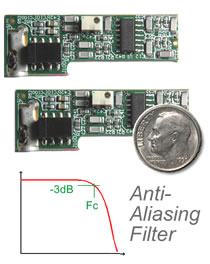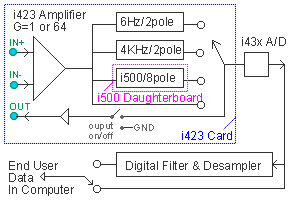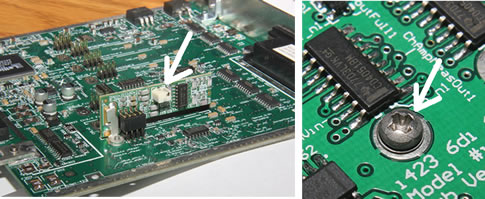MODEL i500 ANTI-ALIASING LOW PASS FILTER
What is an Anti-Aliasing Filter? For a summary of aliasing and why you might need an AFS filter, click here.
The instruNet i4xx card cage is available with 4, 8, 12 or 16 slots. The first slot is used to house the i41x interface card and the 2nd slot is used for the i43x a/d measurement card. One can populate the remaining slots with i423 cards. The i423 provides 6 signal conditioning amplifiers, one for each channel. These can measure voltages, and can also attach directly to common sensors such as thermocouples and strain gages. Each channel on the i423 includes a socket that attaches to a tiny optional 4 x 2 cm daughterboard. This is held in place with one bolt and is installed by the end user. There are four different i500 filter daughters to choose from, each with a different cutoff frequency. Yet optional further digital low pass filtering provides lower cutoff frequencies. For example, one can digitize at 100s/sec/channel with the Fc=1KHz i500 analog filter and digitally filter at Fc=38.5Hz to get anti-aliased 100s/sec/ch data. Internally the system would digitize at ≥ 6Ks/sec/ch and do digital processing to calculate very accurate 100s/sec/ch data. This digital processing is done in the background and the end user only needs to set one software parameter called "Auto Afs" to enable it.
Analog & Digital Filtering via Auto Afs There are two methods of implementing anti-aliasing with instruNet. One method is to oversample, digitally filter, and then desample (Auto Afs ON). The other method involves no oversampling and no digital filtering (Auto Afs OFF). The end user enables Auto Afs with a parameter in the Record Setup dialog box. Both methods result in aliased free data. Auto Afs ON has several advantages:
The two Auto Afs options are described below: 1)
Auto Afs OFF (no digital filtering)
2)
Auto Afs ON (oversample, digital filter, desample)
List of Analog Filter Products Below is a list of products, which are sold in packages of 2 filters per package. Each digitized channel, attached to a sensor, supports one filter daughterboard.
Filter Output Available Electrically at Hd44 Connector Pin Notice the above "Signal Path" illustration has an OUT pin along the left edge. Filter outputs are available electrically at i423 Hd44 connector pins 17 through 22. These are short circuit protected against ±12Volts power on or off; have a drive capability of 3mA and 10K pF via an internal operational amplifier; and have a maximum output working voltage of ±5Volts. These buffered outputs are normally off (0Volts output), and remain off until the end user has turned them on. This can be done by setting Channels #17...22 to ON from within instruNet World software (i.e. click on i423 Ch17..22 in NETWORK page and set Amplifier Output to ON), or writing ON (1=on, 2=off) to those channel addresses via software. The advantage of keeping them off is they are less likely to couple into input signals within the end user's cable. One can use the output pin without digitizing by running the instruNet software and setting the following parameters, as described here (except for enabling for digitize).
Low Pass Filter Theory of Operation
In the passband, a perfect filter has a gain of 1.0, which is the same as 0 dB. Yet real filters vary slightly from 1.0 and this deviation is sometimes referred to as "passband ripple", as illustrated in the above figure. The maximum ripple is specified in the below table for both the i500 analog filter and a 30-pole digital filter which might follow the i500 analog filter.
For example, if one inputs a 400Hz sine wave with amplitude 1Vpp (Volts between top and bottom of sine, peak-to-peak) into an i500-1KHz filter, then the digitize signal would be a 400Hz sine with an amplitude between 0.999Vpp and 1.001Vpp (i.e. 0.1% ripple). And in the frequency range ≤ 300Hz; the output would be between 0.9995Vpp and 1.0005Vpp. A typical 30-pole digital filter often has a variation less than 1 LSB (least significant bit) of the A/D (analog to digital) converter, which means it is close to perfect. The reason digital filters are more accurate is the numerical coefficients used to implement them are accurate to 7 decimals (e.g. 0.00001%) and the resistors and capactors in analog filters are typically accurate to 1%. A potentiometer on the i500 is set at the factory and is used to tune errors from resistors and capacitors. This works to some extent, yet not to the point of making a perfect filter. One reason of which is that resistors and capacitors vary slightly with temperature and with time ("stability"). Therefore setting a potentiometer in the factory while the filter is at one temperature will see a little variation later when the filter in the field is at a slightly different temperature. All i500 analog filter daughterboards uses NPO/COG capacitors that are accurate to approximately 1% in initial value, and drift very little with temperature (e.g. 30ppm/C); and are therefore very accurate. A common problem in filter design is lower frequency filters (e.g. < 100Hz Fc) need larger capacitors and larger capacitors are often not available in accurate and stable materials. The i500 filter product family deals with this by providing the i500-380Hz lowest Fc filter (which uses accurate capacitors) and then provides lower Fc's to the end user with digital filtering and desampling that follows the analog filtering. Therefore, the end user can enjoy extremely accurate data (e.g. < ±0.002 dB ripple) at lower Fc frequencies.
The stopband involves frequencies in excess of the cutoff frequency. Stopband minimum attenuation for both the i500 8-pole analog filter and 30 pole digital filter (which might follow i500) are shown in the below table.
For example, if you digitize at 200s/sec/channel (100Hz nyquist) with a i500-1KHz analog filter and Auto Afs enabled, then the instruNet system will internally digitize faster (e.g. ≥ 6Ks/sec/ch), pass the signal through the i500 analog filter (Fc = 1KHz), run a 30-pole digital filter (Fc = 76Hz) and provide > 72dB of attenuation at the 100Hz nyquist frequency (1.3 * 76 Hz = 100 Hz). In this example, one would have < ±0.02% (±0.002 dB) passband ripple for frequencies < 61Hz (0.8 * 76Hz = 61Hz).
The following steps are required to set up an i500 low pass filter:
i500 Filter Hardware Installation The i500 filter daughterboard bolts to the i423 card, one daughterboard per channel, as shown in the below photo. When installing the i500, make sure the 2-56 bolt is snug. Obviously, one needs to remove the i423 card before installing the i500 daughterboard. The i423 sockets are labeled "Ch 1", "Ch3", etc.
Auto Afs Engage Indicators
Channel Report from DASYLab Software
Digitize Channel Report Columns
|

 The diagram to the right shows the signal path when working with the i500 analog filter.
The signal first passes through the
The diagram to the right shows the signal path when working with the i500 analog filter.
The signal first passes through the
 The figure to the right describes a low pass filter.
In summary, a low pass filter passes low frequencies and attenuates
high frequencies. The transition from the passband to the stopband
occurs in the vicinity of the cutoff frequency, commonly referred
to as "Fc" in units of Hz. It is here that the signal is attenuated 3dB,
which corresponds to a 70% attenuation in amplitude voltage.
For example, if you input a 1KHz 10Vpp (volts peak-to-peak)
sine wave into a filter with a 1KHz Fc, then the output will be
1KHz 7Vpp. Power is porportional to the square of the Voltage,
therefore a 70% attenuation in voltage is associated
with a 50% (70% * 70%) attenuation in power.
The figure to the right describes a low pass filter.
In summary, a low pass filter passes low frequencies and attenuates
high frequencies. The transition from the passband to the stopband
occurs in the vicinity of the cutoff frequency, commonly referred
to as "Fc" in units of Hz. It is here that the signal is attenuated 3dB,
which corresponds to a 70% attenuation in amplitude voltage.
For example, if you input a 1KHz 10Vpp (volts peak-to-peak)
sine wave into a filter with a 1KHz Fc, then the output will be
1KHz 7Vpp. Power is porportional to the square of the Voltage,
therefore a 70% attenuation in voltage is associated
with a 50% (70% * 70%) attenuation in power.

 After setting up the system, one can easily learn more about
bandwidth and aliasing by selecting
"Digitize Channels Report" under Setup in the menubar, as illustrated to the right.
This prints a table that
describes channels
After setting up the system, one can easily learn more about
bandwidth and aliasing by selecting
"Digitize Channels Report" under Setup in the menubar, as illustrated to the right.
This prints a table that
describes channels